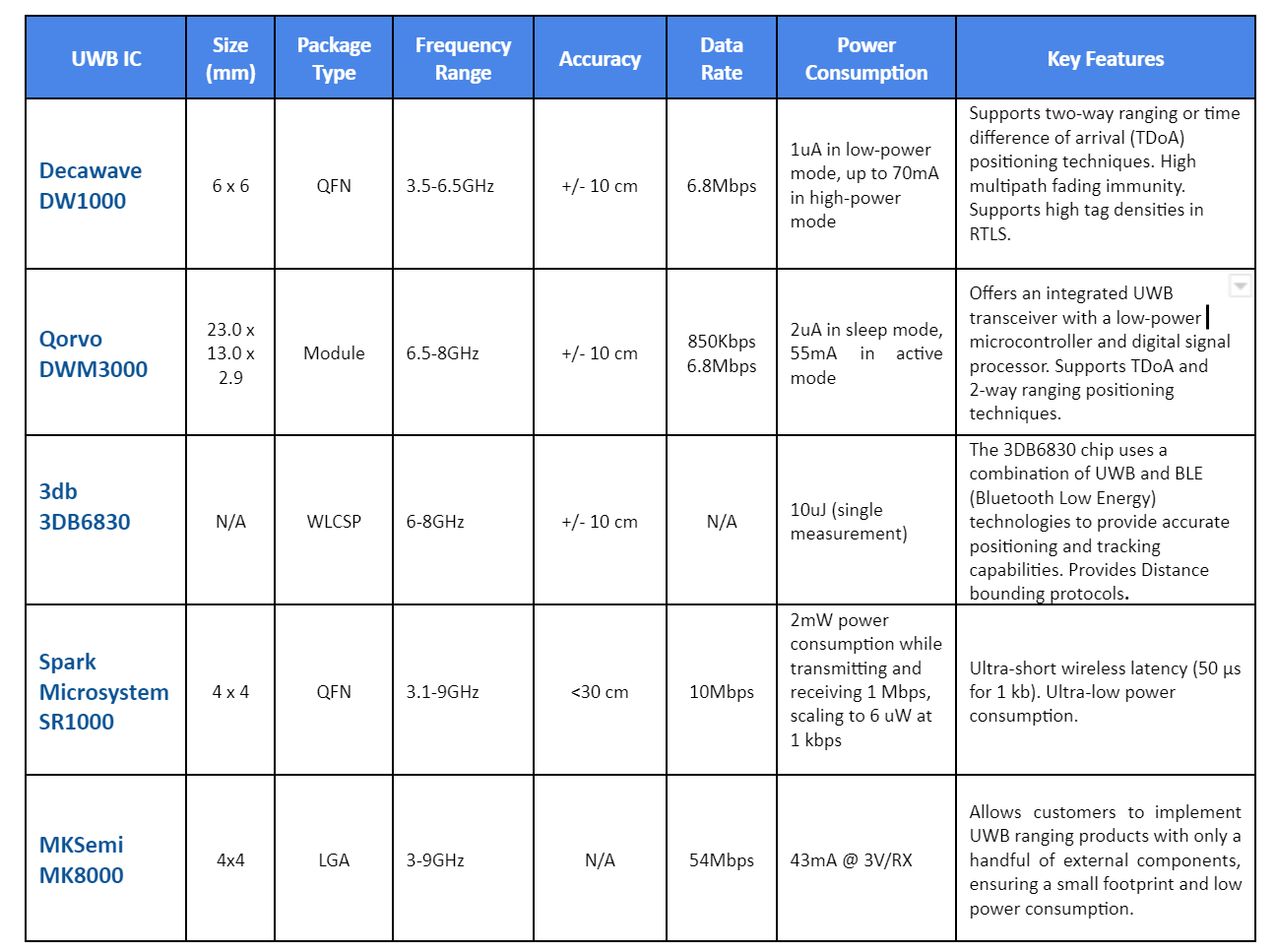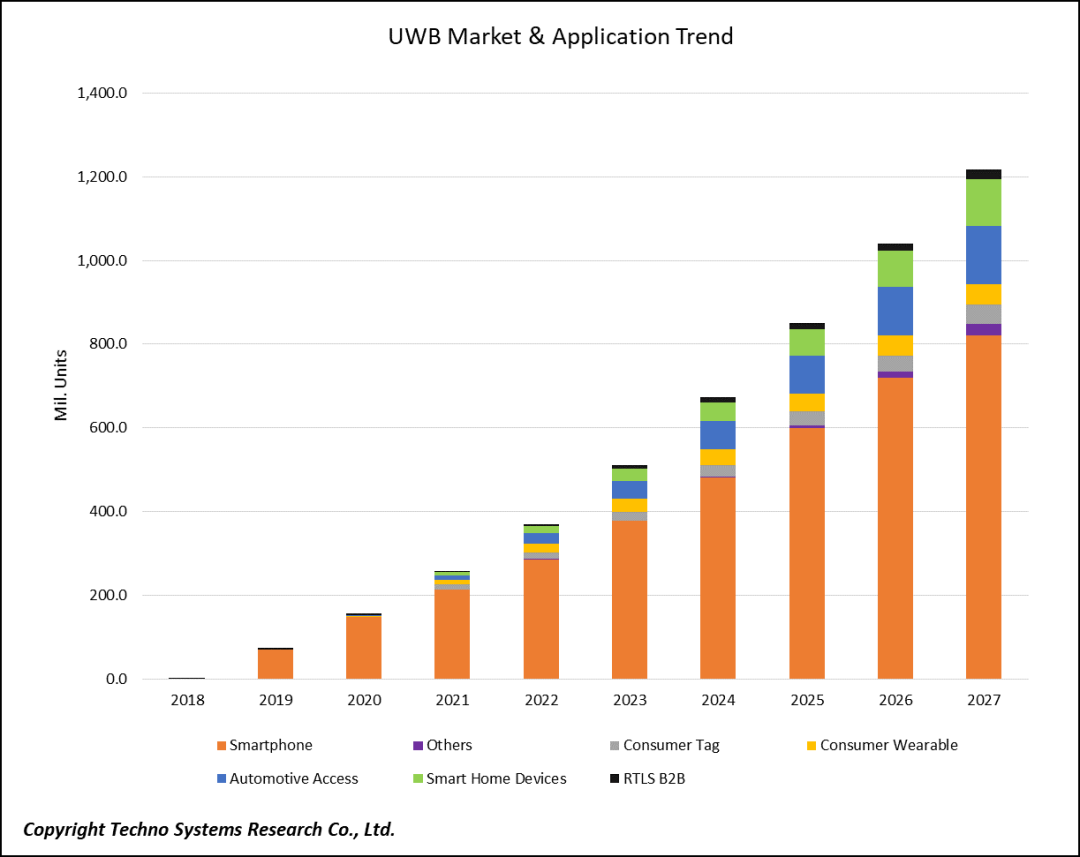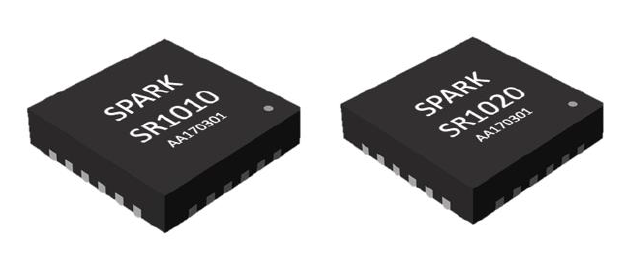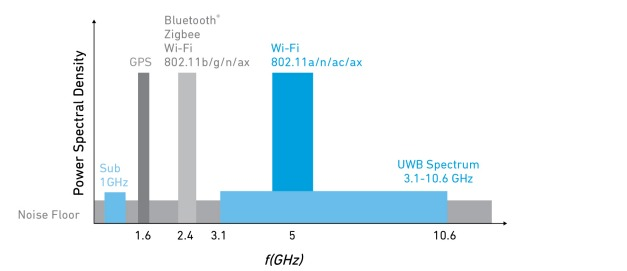This website uses cookies so that we can provide you with the best user experience possible. Cookie information is stored in your browser and performs functions such as recognising you when you return to our website and helping our team to understand which sections of the website you find most interesting and useful.
5+ Best UWB Chipset Providers Compared
16/03/2023, hardwarebee
Ultra-Wideband (UWB) technology is a wireless communication protocol that utilizes short-range, high-bandwidth radio waves to transmit and receive data over short distances. UWB chips are a key component of UWB technology, and they are used in a variety of applications such as location tracking, wireless charging, and data transfer.
Market research firm ABI Research said that despite UWB being early in its ecosystem development, it is fast becoming a major short-range wireless technology. UWB-enabled devices are forecasted to reach more than 1.3 billion shipments by 2026, growing from 143 million in 2020.
UWB chipset work by emitting short pulses of radio waves that span a very wide frequency range, typically between 3.1 and 10.6 GHz. These short pulses are transmitted at a very high frequency, enabling UWB devices to achieve data transfer rates that are much faster than other wireless technologies such as Bluetooth and Wi-Fi.
One of the key advantages of UWB technology is its ability to provide very accurate positioning and location tracking, which makes it an ideal technology for indoor navigation, asset tracking, and other location-based services. In addition, UWB technology can also be used for wireless charging and data transfer, making it a versatile technology for a variety of applications.
As UWB technology continues to evolve, UWB chips are becoming smaller, more affordable, and more widely available, which is driving adoption across a variety of industries. From healthcare and automotive to smart home and industrial IoT, UWB technology is poised to revolutionize the way we connect and communicate in the digital age.
In this report, we will introduce UWB chips, their applications, limitations, and key features. In the end, we compare three UWB chips together and look through their specifications.
What is an UWB Chip?
UWB stands for Ultra-Wideband, which is a wireless communication technology that uses a large portion of the radio frequency spectrum to transmit data over short distances with high precision and accuracy.
A UWB chip is a semiconductor device that is specifically designed to implement UWB technology. It contains the necessary hardware blocks to transmit and receive UWB signals and is typically used in applications that require high data transfer rates, low power consumption, and accurate location tracking.
UWB chips can be found in a variety of devices, such as smartphones, smartwatches, and IoT sensors. They are used in a range of applications, including indoor navigation, asset tracking, automotive sensing, and smart home automation.
Figure 1: UWB chipset
Benefits of UWB Chips
UWB (Ultra-Wideband) technology offers several benefits that make it a popular choice for many applications. Here are some of the main benefits of UWB:
High Precision: UWB technology provides extremely accurate and precise location tracking, which makes it ideal for use in applications that require highly accurate spatial awareness, such as indoor navigation and asset tracking.
High Data Transfer Rates: UWB technology is capable of transmitting data at very high speeds, which makes it ideal for applications that require large amounts of data to be transferred quickly and efficiently.
Low Power Consumption: UWB technology requires very little power to operate, which makes it ideal for use in battery-powered devices, such as smartwatches and IoT sensors.
Low Interference: UWB operates at a very low power level and uses a large portion of the radio frequency spectrum, which makes it less susceptible to interference from other wireless devices.
Security: UWB technology uses a unique and highly secure form of communication, which makes it difficult for unauthorized parties to intercept or access the transmitted data.
Versatility: UWB technology can be used in a wide range of applications, including indoor navigation, asset tracking, automotive sensing, and smart home automation. Its versatility makes it a popular choice for many different industries and use cases.
Overall, UWB technology offers a number of benefits that make it an attractive choice for many different applications, especially those that require high precision, high data transfer rates, low power consumption, and secure communication.
UWB Applications
UWB (Ultra-Wideband) technology has many different applications across a range of industries. Here are some examples of how UWB technology is used:
- Indoor Navigation: UWB technology can be used for precise indoor navigation in large buildings or complex environments. UWB signals can accurately determine a user’s location and track their movement in real time.
- Asset Tracking: UWB technology can be used to track the location and movement of assets, such as equipment, vehicles, and inventory, within a facility. This can help to improve operational efficiency and reduce losses.
- Automotive Sensing: UWB technology can be used for sensing and detection in vehicles, such as detecting the presence of passengers or objects in a car. This can be used for safety and security applications, such as airbag deployment and theft prevention.
- Smart Home Automation: UWB technology can be used to control and automate smart home devices, such as smart locks, lighting, and temperature control. UWB signals can accurately detect the location of users and adjust settings accordingly.
- Healthcare: UWB technology can be used for remote monitoring and tracking of patients, as well as tracking and monitoring medical equipment and supplies.
- Robotics: UWB technology can be used for navigation and mapping in robotics, enabling precise movement and positioning in complex environments.
Overall, UWB technology has many different applications and is increasingly being used in a wide range of industries and use cases.
Figure 2: UWB applications (source: Qorvo)
UWB Chip Operating Principles
UWB chips typically use a technique called impulse radio, where very short duration pulses of RF energy are transmitted over a wide range of frequencies. These pulses are typically only a few nanoseconds in duration, and are spread across a wide frequency band. The operating principles of a UWB (Ultra-Wideband) chip depend on the specific design and functionality of the chip. However, in general, UWB chips operate on the principle of transmitting short, high-frequency pulses across a very wide frequency range.
Here are the main operating principles of a typical UWB chip:
Pulsed Transmission: UWB chips transmit very short pulses of radio waves, typically lasting a few nanoseconds to a few picoseconds. These pulses are transmitted across a very wide frequency range, often spanning several gigahertz.
Low Duty Cycle: UWB chips typically have a very low duty cycle, meaning that the pulses are only transmitted intermittently. This helps to minimize power consumption and reduce interference with other wireless devices.
Time-Domain Reflectometry (TDR): UWB chips use a technique called Time-Domain Reflectometry (TDR) to measure the time it takes for the transmitted pulses to reflect back to the receiver. By measuring the time delay between the transmitted and received pulses, the distance to the target can be accurately calculated.
High Precision: UWB chips are capable of very high precision location tracking, with accuracy down to a few centimeters or less. This is achieved through precise timing and synchronization of the transmitted and received pulses, as well as advanced algorithms for signal processing and analysis.
Figure 3: UWB Impulse Radio System (source: IEEE P802.15)
Overall, UWB chips operate on the principles of transmitting short, high-frequency pulses across a wide frequency range, using TDR to measure the time delay between transmitted and received pulses, and achieving high precision location tracking through advanced signal processing and analysis.
UWB Distance and Accuracy
Several factors can affect the distance and accuracy of UWB (Ultra-Wideband) technology. Here are some of the main factors:
Signal Strength: The strength of the UWB signal can have a significant impact on the distance and accuracy of the technology. Stronger signals can travel further and penetrate through obstacles better than weaker signals.
Frequency Range: The frequency range of the UWB signal can also affect its performance. UWB signals that operate in lower frequency ranges tend to have better penetration through obstacles, but they may not be as accurate as higher frequency signals.
Antenna Design: The design of the UWB antenna can also have an impact on the performance of the technology. Antennas that are optimized for UWB signals can provide better signal strength and accuracy than those that are not.
Line of Sight: The presence of obstacles between the transmitter and receiver can significantly impact the accuracy and distance of UWB technology. UWB signals perform best in environments with a clear line of sight between the transmitter and receiver.
Environmental Conditions: Environmental conditions, such as temperature, humidity, and electromagnetic interference, can also affect the performance of UWB technology. These factors can cause signal degradation or interference, which can impact the accuracy and distance of UWB signals.
Timing and Synchronization: UWB technology relies on precise timing and synchronization of the transmitted and received pulses to calculate distance and location accurately. Any errors or inconsistencies in timing and synchronization can cause inaccuracies in the location tracking.
Overall, several factors can impact the distance and accuracy of UWB technology, including signal strength, frequency range, antenna design, line of sight, environmental conditions, and timing and synchronization. By optimizing these factors, it is possible to achieve high levels of accuracy and distance with UWB technology.
Figure 4: UWB Bandwidth (source: Qorvo)
UWB Chip Manufacturers Overview
There are several companies that manufacture UWB (Ultra-Wideband) chips for various applications. Here are the top companies:
Qorvo
Qorvo is a global semiconductor company headquartered in North Carolina, USA. The company was formed in 2015 as a merger between RF Micro Devices and TriQuint Semiconductor, two leaders in the radio frequency (RF) technology industry. Qorvo specializes in developing and manufacturing a wide range of advanced RF products and solutions, including UWB chips for applications including secure communication and asset tracking. Located in Greensboro, North Carolina, United States.
Qorvo’s products and solutions are used in a variety of markets, including wireless infrastructure, defense and aerospace, automotive, and Internet of Things (IoT) applications. The company has a strong focus on innovation and has received numerous awards and recognitions for its products and solutions.
In addition to its UWB chips, Qorvo produces a wide range of RF components, including amplifiers, filters, switches, oscillators, and more. The company also offers a range of software and design tools to help customers integrate its products into their applications.
Qorvo has taken several measures to decrease its environmental footprint, demonstrating a dedication to sustainability. The company has set targets to reduce its greenhouse gas emissions, water usage, and waste production, among other goals.
Overall, Qorvo is a leading player in the RF technology industry and is well-positioned to continue innovating and delivering advanced solutions to its customers in a variety of markets.
Spark Microsystems
Spark Microsystems is a semiconductor technology company based in Montreal, Canada. The company was founded in 2016 by a team of industry veterans to develop high-performance wireless communication solutions for a variety of applications. Based in Montréal, Quebec, Canada.
Spark Microsystems specializes in developing ultra-low power wireless transceiver technology that is designed to operate in harsh environments and challenging signal conditions. The company’s technology is based on a proprietary ultra-wideband (UWB) radio architecture that allows for high-speed, low-latency communication with minimal power consumption.
Spark Microsystems’ UWB transceiver technology is well-suited for a variety of applications, including IoT, smart homes, industrial automation, and automotive applications. The technology enables high-precision positioning, motion sensing, and wireless data transfer, among other functions.
The company has received several awards and recognitions for its technology, including being named a Top 10 Canadian Tech Company to Watch by Betakit in 2020.
Overall, Spark Microsystems is a promising semiconductor technology company that is developing advanced UWB transceiver technology for a variety of applications. As the demand for high-performance wireless communication solutions continues to grow, the company is well-positioned to play a leading role in the industry.
Mauna Kea Semiconductors
MKSemi, the prominent company in low-power ultra-wideband (UWB) technology, offers a comprehensive, high-accuracy location solution to original equipment manufacturers (OEMs) and original design manufacturers (ODMs) of devices. Founded in 2019 by UWB pioneers, the company makes the world’s lowest power, highest integrated chip solution, currently, the best solution that empowers IoT devices with the smallest batteries and size, with high-precision sensing. MKSemi’s hardware and software technologies enable quick product development, integration, and deployment. MKSemi is endorsed by Oppo, Lightspeed China Partners, Gaorong Capital, Qiming Venture, SV Tech Ventures, Ivy Capital, CFT Capital, and iCamp Capital. Its next-generation location solutions are currently being integrated into smartphones and automobiles and are poised to dramatically bolster consumer and industrial IoT applications ranging from smart homes and cities to automobiles, wearables, and health monitoring devices. Based in San Jose, California.
Novelda
Novelda AS is a technology company based in Norway that specializes in developing innovative radar sensor solutions for a range of applications. The company was founded in 2004 by CEO Cornelia Mender and CTO Aage Kalsaeg, with the aim of commercializing advanced radar technology based on research conducted at the University of Oslo. Located in Oslo, Norway.
Novelda’s technology is based on using low-power radar to detect and measure a wide range of physical properties, including motion, distance, speed, and biometric data such as heart rate and respiration. This makes their technology ideal for use in applications such as home automation, industrial automation, security and surveillance, healthcare, and automotive.
One of Novelda’s flagship products is the XeThru sensor module, which is a small, low-power radar module that can be integrated into a range of devices and systems. The XeThru technology is capable of detecting movement and tracking people even through walls, making it ideal for use in security and surveillance applications. It can also be used in healthcare to monitor vital signs and detect falls.
Novelda has received several awards and recognition for their innovative technology and has established partnerships with a range of companies in different industries. The company continues to develop and refine their radar technology, with the goal of enabling more efficient and intelligent systems that can improve people’s lives.
NXP
NXP Semiconductors N.V. is a semiconductor manufacturer of Dutch-American origin, with its headquarters located in Eindhoven, Netherlands. It was founded in 1953 as part of Philips, and became an independent company in 2006. NXP focuses on developing and producing mixed-signal and standard product solutions for a variety of industries, including automotive, security, mobile, IoT, and networking. Located in Eindhoven, Netherlands.
NXP is a major player in the automotive industry, providing integrated circuits and other solutions for advanced driver assistance systems (ADAS), vehicle electrification, and infotainment. The company is also known for its secure identification solutions, which are used in passports, credit cards, and other applications where security is paramount.
In addition to its hardware offerings, NXP has also developed a range of software solutions and platforms, including operating systems and middleware for the IoT and embedded markets.
NXP has a global presence, with operations in over 30 countries and customers in more than 150 countries. The NASDAQ stock exchange has listed the company, which has a market capitalization of approximately $45.43 billion as of March 2023.
3DB Access
3db Access AG is a Swiss-based company that specializes in access control solutions for critical infrastructure facilities, including data centers, server rooms, and other high-security areas. Located in Zurich, Switzerland.
Developer of a next-generation power single chip designed to solve the problem of securing applications and systems relying on proximity verification. The company’s chip uses ultra-wideband signaling in order to deliver low power and provably secure technology from the logical layer down to the physical layer and offers security-critical applications including keyless access control to vehicles, buildings, and mobile payments, enabling customers to get secure proximity verification while keeping the convenience and high usability of the current systems.
The company was founded in 2013 and has since become a leading provider of innovative, reliable, and secure access control systems. Some of its key products include biometric fingerprint readers, smart card readers, keyless access control systems, and digital video surveillance solutions.
The company is headquartered in Zurich, Switzerland, and is known for its high-quality products, excellent customer service, and innovative approach to access control.
UWB Chipset Comparison
In this part, for understand better and find out which UWB chip is better we are going to compare some of UWB chips.
Here’s a brief comparison of UWB (Ultra-Wideband) chips from different manufacturers:
Decawave DW1000
- Frequency range: 3.5GHz to 6.5GHz
- Operating Temp.: -40-85 °C
- Accuracy: +/- 10 cm
- Power consumption: 1uA in low-power mode, up to 130mA in high-power mode
- Key features: Supports two-way ranging or time difference of arrival (TDoA) positioning techniques. High multipath fading immunity. Supports high tag densities in RTLS.
Figure 5: DW1000 IC Block diagram
Qorvo DWM3000
- Frequency range: 6.5GHz to 8GHz
- Operating Temp.: -30-85 °C
- Accuracy: +/- 10 cm
- Power consumption: 14mA in active mode, 2uA in sleep mode
- Key features: Offers an integrated UWB transceiver with a low-power microcontroller and digital signal processor. Supports TDoA or 2-way ranging positioning techniques. Provides a range of built-in security features.
Figure 6: Qorvo DWM3000 diagram
Overall, all three UWB chips have similar accuracy and modulation schemes. The Decawave DW1000 and Nanotron Swarm Bee ER operate in lower frequency ranges, while the Qorvo DWM3000 operates in a higher frequency range. Qorvo DWM3000 offers advanced security features. The choice of UWB chip will depend on the specific requirements of the application and the available budget.
3db Access 3DB6830
- Frequency range: 6 GHz to 8 GHz
- Operating Temp.: -30-85 °C
- Accuracy: +/- 10cm
- Power consumption: 10uJ
- Key features: The 3DB6830, 3db’s primary and extensively consolidated ultra-low power IR-UWB transceiver, has key characteristics such as an integrated security layer that enables secure distance bounding and data communication. Additionally, the 3DB6830 comes with a purpose-built MAC layer that has been formally validated for security applications in distance bounding and data communication.
Figure 7: 3DB6830 Block diagram
Spark Microsystem SR1010
- Frequency range: 3.1GHz to 6GHz (6- 9.25 GHz in SR1020)
- Operating Temp.: -30-85 °C
- Accuracy: <30 cm
- Power consumption: 2mW power consumption while transmitting and receiving 1 Mbps, scaling to 6uW at 1 kbps
- Key features: The SR1010 is a highly adaptable solution that can accomplish extremely low power usage at various data rates. This makes it an ideal option for wireless applications that require high levels of energy efficiency, low latency, versatile operation, or dependable communication. The transceiver provides ultra-short wireless latency of 50 µs for 1 kb, and its output spectrum can be dynamically shaped to comply with international UWB emission restrictions or adapt to a broad spectrum of spectral masks. Furthermore, its circuits are aggressively duty-cycled to enable ultra-low power operation. The ASIC is composed of an impulse radio with an RF transmitter and receiver, power management unit, sleep counter and digital / baseband hardware. The application-specific integrated circuit (ASIC) communicates with a microcontroller unit (MCU) that operates the link layer through an SPI interface.
SR1000: Get more details, prices and support here.
Figure 8: Spark Microsystem SR1010 Block diagram
MK Semi MK8000

The new MK8000 chip, which integrates processor, radio and peripherals, allows customers to implement UWB ranging products with only a handful of external components, ensuring small footprint and low power consumption.
- Ultra-low power consumption: at 43mA@3V/RX.
- Wide frequency band: supports widest UWB band 1 and 2 (3.1 GHz to approximately 9 GHz), enabling global UWB operation with backward compatibility capability.
- High level of integration: chip’s high level of integration with integrated TRX switch and matching network, Arm Cortex M0 MCU with multiple RF channel 4 RX and 1 TX for full ranging and AoA measurement lowers BOM cost and helps speed up deployment.

UWB Chips Comparison Table

Click here for a high resolution table.
Summary
The Decawave DW1000, Qorvo DWM3000, 3db 3DB6830, and Spark Microsystems SR1010 are all ultra-wideband (UWB) chips or modules designed for use in a variety of applications such as location-based services, asset tracking, and secure wireless communication. While each of these chips has unique features and specifications, they share some similarities and differences that can be compared:
- Size and Weight: All of these UWB chips/modules are designed to be small and lightweight, with sizes ranging from a few millimeters to a few centimeters and weights ranging from a few milligrams to a few grams. The specific size and weight of each chip/module can vary depending on the specific configuration and packaging used by the manufacturer.
- Architecture: Each of these UWB chips/modules has a unique architecture that is designed to optimize performance for specific applications. For example, the Qorvo DWM3000 uses a CMOS-based architecture to achieve low power consumption and high data rates.
- Operating Frequency: The operating frequency of each chip/module can also vary, with most operating in the range of 3.1 GHz to 10.6 GHz. It depends on the application.
- Price: The price of each chip/module can vary depending on the specific configuration, packaging, and volume ordered.
Overall, each of these UWB chips/modules has its own unique features and strengths that can be optimized for specific applications. The choice of which chip/module to use will depend on the specific needs of the application, such as range, accuracy, power consumption, and cost.






















